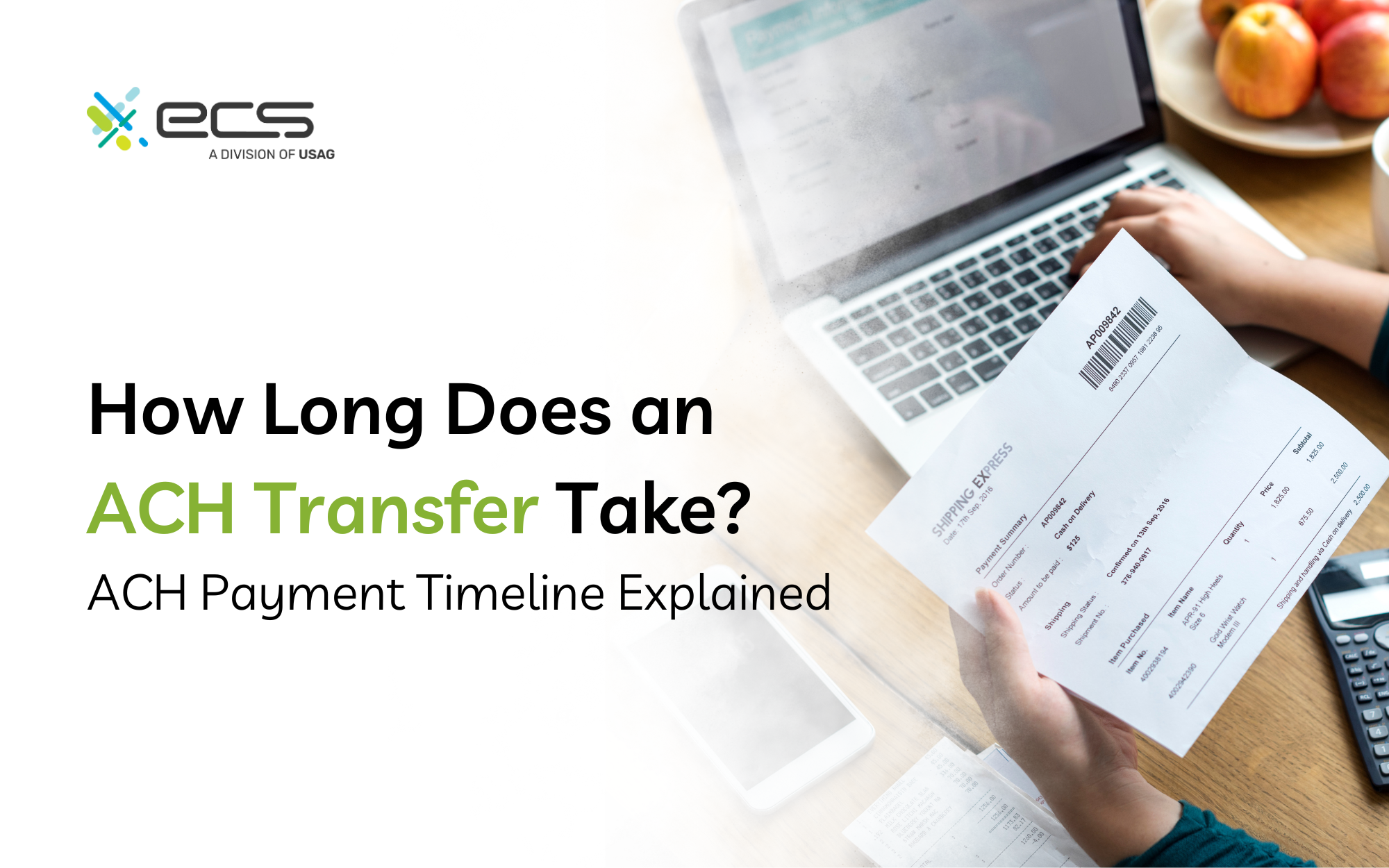How Long Does an ACH Transfer Take? That simple question can quickly become a major concern for business owners. ACH payment timelines aren’t always easy to decode. If you don’t fully understand how long an ACH transfer takes for businesses, it can throw off your cash flow, delay vendor payments, or even cause a domino effect across your operations. With some more clarity and smarter planning, you can work more in sync with the system; and ECS Payments is here to help you do exactly that.

Understanding ACH Network Rules
Unlike card payments that authorize nearly instantly, ACH transactions are processed in batches. Banks submit payments to a central ACH operator, like the Federal Reserve, which routes them to the receiving bank for settlement.
NACHA, the National Automated Clearing House Association, governs the system. NACHA establishes the guidelines for submitting, processing, and posting ACH transfers between bank accounts.
For example, banks are typically required to post incoming credits by 8:30 a.m. local time on the settlement date. NACHA also enforces return windows for issues such as unauthorized debits or incorrect account details.
These rules ensure consistency, security, and compliance. While ACH transfers may not be the fastest payment option available, it is reliable and regulated and a go to method widely used for payroll, billing, and vendor payments.
How long does an ACH transfer typically take for businesses? Typically, standard ACH payments take one to three business days to complete, but timing depends on several factors:
- Whether it’s a credit or a debit
- Time of day the payment is submitted
- Batch processing schedules
- Weekends and holidays

Why Some Transfers Take Longer
ACH credits, such as payroll or vendor payments, typically process faster than debits, which require the customer’s bank to verify available funds. Timing also plays a role. Most banks have submission cutoffs in the late afternoon. If a payment is submitted after 4 p.m. Eastern time, it won’t process until the next business day.
Not to mention if the late submission lands on a Friday. In that case, it won’t process at all on the following two days (Saturday and Sunday). Additionally, mistakes such as an incorrect routing number or insufficient funds can trigger a return and cause further delays and accrue more costs.
While ACH is not as fast as real time systems, it remains a cost effective and reliable solution for businesses that frequently use bank transfers.

Example Scenarios For ACH Timelines
Scenario 1
You run a marketing agency that bills retainer clients via ACH debit on the 1st of each month. This month, the 1st falls on a Friday, and your payment batch is sent out after the 4 p.m. cutoff. Since you missed the window, processing will begin the following business day, which is Monday. That pushes settlement to midweek, potentially delaying payments for payroll, rent, or vendors.
Scenario 2
You send a B2B payment to your manufacturer on Friday, May 23rd, at 5 p.m. You’ve already missed the daily cutoff. Saturday and Sunday are non-processing days on the ACH network, and Monday is Memorial Day. That means the transaction won’t begin processing until Tuesday, with funds likely not settling until Thursday, almost a full week after submission.
If there’s an error, such as a wrong routing number, mismatched name, or insufficient funds, the transfer will be returned, forcing you to reprocess and wait all over again.

Speeding Things Up with Same Day ACH
If you’re under pressure to move money faster, same day ACH transfers are the solution. In the first quarter of 2025, same day ACH volume jumped to over $8.7 billion, indicating that more businesses are taking advantage of the faster option.
While it is not technically instant, same day ACH clears several times per day, rather than once. That can make a big difference for urgent payroll, refunds, or last minute vendor payments. However, these faster transfers usually come with additional fees, and the submission window is earlier than you might expect. Submitting even a few minutes after the cutoff pushes your transaction to the next cycle.

Make Timing Part of Your Cash Strategy
Understanding how long an ACH transfer takes for businesses allows you to be more intentional with your scheduling. For example, if payroll needs to land in employee accounts by Friday, we recommend submitting your files by Wednesday morning for standard ACH, or Thursday morning if you’re using same day ACH.
This kind of planning also helps with recurring payments from customers. Setting proper expectations about how long it takes to post their payment gives your business a more professional and reliable image. Understanding how push and pull payments work can help you design the right experience for your billing cycle.

How ECS Payments Helps You Stay in Control
ACH rules don’t just affect timing; they also impact risk management. A savvy business owner doesn’t just want to know how long a payment takes, but how to avoid delays, returns, and unexpected fees.
ECS Payments reduces the guesswork from ACH processing. We help our businesses monitor processing times, alert you to bank cutoff schedules, and assist you in selecting the most suitable transfer method for each transaction. Our tools assist in:
- Batch scheduling
- Payment confirmation
- Account verification
- Reducing rejected payments caused by insufficient funds
When it comes to ACH payment timelines, the more you understand, the better you can plan. Knowing how long an ACH transfer takes for businesses gives you the control to avoid delays, improve your financial accuracy, and keep relationships strong with vendors and employees.
Ready to explore additional payment methods for your business? Talk with our team today and get a strategy built for your business and your timeline.
Frequently Asked Questions
Most banks’ cutoff time is between 3:00 p.m. and 5:00 p.m. Eastern. If you submit a transfer after the cutoff, it won’t begin processing until the next business day. ECS Payments helps you plan around these deadlines with alerts and scheduling tools.
ACH payments are difficult to cancel once they’ve been submitted. However, if there’s a duplicate transaction, incorrect amount, or fraudulent charge, a reversal may be possible within a short window. ECS Payments provides tools to catch errors before submission and guidance if a reversal becomes necessary.
No. The ACH network does not process transactions on Saturdays, Sundays, or federal holidays. If a payment is submitted just before a weekend or holiday, processing will be delayed until the next available business day.
Yes, but only if the payment is submitted before the designated cutoff, usually around 4:45 p.m. Eastern Time. Same day ACH still follows business day schedules and is subject to volume limits and additional fees. It’s faster than standard ACH, but not truly real time.
